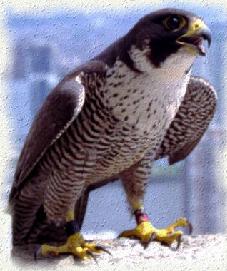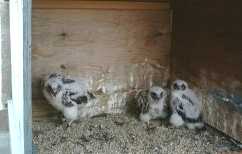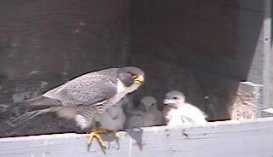|
Wildlife Conservation Corps Volunteer April 1, 2004 As cool spring weather follows a brutally cold winter, we invite you to sit back in whatever warm place you happen to be in, close your eyes, and spend a few moments traveling back in time as we tell a story of tragedy and eventual triumph.
Every good story must have its heroes and villains, and this one is no exception. The villain is obvious. DDT and its related pesticides had taken a terrible toll on our wildlife. Pete McLain is the first of the heroes. In 1973, Mr. McLain was the Deputy Director of the New Jersey Division of Fish and Wildlife. He was one of the guiding forces behind the passage of the NJ Endangered and Nongame Species Conservation Act of 1973. The act became law on December 14, 1973, two weeks before then-President Nixon signed the Federal Endangered Species Act into being. As a result of this legislation, the NJ Endangered and Nongame Species Program was created within the Division of Fish and Wildlife, with JoAnn Frier-Murza serving as its first Chief until Dr. Larry Niles, the current Chief of ENSP, took over in 1990. Pete McLain then made another extraordinary contribution. He forged a partnership with Dr. Tom Cade of the Peregrine Fund, another hero in peregrine annals, whose work is largely responsible for the falcon's recovery in the East. Dr. Cade, then a Professor of Ornithology at Cornell University, was involved with attempting to re-establish peregrines in the wild by releasing or "hacking" young falcons, which had been raised in captivity. He was looking for states willing to cooperate in this venture. Falconers are another early addition to the list of heroes/heroines. They often get a bad rap because of the actions of a few. But without these devoted individuals and their work in captive breeding, there would be no story at all.
Hacking is an
old falconer's term for a process that provides captive-bred youngsters with a
sheltered experience in learning to fly and hunt, giving them the advantage of
a "soft release" into the wild. When the young falcons reach their normal fledging age of 5-6 weeks, the box is opened so the birds can fledge, or fly, for the first time. The hack site attendants observe the young birds each day, and continue to provide food until the falcons become proficient at catching their own prey, a period that usually lasts about six weeks. The heroes list must also include all the early ENSP biologists who were involved in the hacking program. They gave so much of themselves to its success, not even knowing if that success would ever come. Their dedication was boundless. Generally, hack sites were situated in areas where traditional aeries had been located. Unfortunately, another side effect of the DDT years was the movement of great horned owls into areas formerly occupied by peregrines, with the result that many young falcons became prey for these owls. We did mention tragedy at the beginning of this story, and these losses were heartbreaking. Biologists began hacking birds at coastal towers, and peregrine falcons also took up residence on bridges and tall buildings such as 101 Hudson Street, which had the some of the same advantages as sheer cliffs, but were free of great horned owls. The alliance between Pete McLain and Tom Cade proved to be a sound one. In 1980, New Jersey became the first state east of the Mississippi to have a wild nesting, at Forsythe National Wildlife Refuge. New Jersey biologists hacked approximately 55 birds between 1975 and 1980. Between 1981 and 1985 ENSP supplemented a few nests with captive-bred chicks each year. Amazingly, since then it has all been wild-produced, steadily growing to eighteen nests by 2003, all on towers, bridges and buildings. The peregrine had become largely a city bird. So it seems only fitting, as we fast-forward thirty years, that in the spring of 2003, as we celebrated the thirtieth anniversary of the NJ Endangered and Nongame Species Conservation Act, the peregrine falcon provided us with yet another "first." A pair of peregrines established a nest ledge in the Palisades Interstate Park, an historic nest site, on a sheer rock face overlooking the Hudson River. Four eggs were laid, but only one hatched, not at all uncommon with first-time nesters. A male fledged from the nest on July 2, flying as if born to the air, thus becoming New Jersey's first peregrine falcon to fledge from a natural nest site in over 50 years. A second pair of birds claimed a ledge five miles distant, but that nest failed, also not unusual for a first-year attempt. These were the first natural nests in the state in over fifty years.
Here is the truly amazing thing about New Jersey: We live in a place where peregrine falcons can soar in the most urban of settings, like Jersey City and Newark, and also on our coastal marshes and in a place where they first raised young hundreds and hundreds of years ago. It says a lot about our scrappy little state. The other significant part to this story is what a cooperative effort it has been: We have mentioned some of the primary characters in this modern-day fairy tale, but there are so many others. Corporations such as Verizon, which provides our 101 Hudson St. Webcam, and LCOR, which has given such support to the birds (and biologists) at 101 Hudson. The corporations such as PSE&G and AT&T, who build towers and give us access to their sites, and contribute financially as well. The staff at the Atlantic City Hilton Casino and the many bridge managers who offer help and protection to their resident falcons. The officers of the Palisades Interstate Parkway Police Department, who appreciated the significance of that first cliff falcon, and kept him under police protection until his safe fledging. Many corporate citizens have long supported the work of our Conserve Wildlife Foundation. And we must also thank Linda Tessauro and her band of incredibly hard-working angels, who have made Conserve Wildlife a reality. It is also quite true that the restoration of our endangered birds of prey would not have happened without a lot of help from people just like you. We would like to thank all of you who buy our wildlife conservation plates, which provides funding for so many ENSP programs. And all of you who regularly Check Off for Wildlife each year at tax time. This is our primary source of income. Most of all, we salute the volunteers who go out there in all kinds of weather and endure biting bugs and hostile habitats, in order to spend their "leisure" time monitoring New Jersey's endangered species. If any of you reading this are suffering from bad end-of-winter cabin fever, and are looking for something fulfilling to do, learn about the Wildlife Conservation Corps and how you might fit in. Come on out and join us. Last but hardly least, we thank all the 101 Hudson Street viewers, who watch and learn from the falcons of Jersey City. Some of you have called and written to us with your observations--many times you have seen things that we have missed, and more than once have saved the life of a young falcon by your alertness and concern. All of you are a vital part of the peregrine falcon recovery in New Jersey. As we said at the beginning of this tale, spring is here, the diurnal cycle is lengthening, and the peregrines of skyscraper and cliff are once again beginning to move to the ancient rhythms of their kind. Our Webcam will be following the progress, and one morning soon, you may indeed be watching as peregrines take to the air over Jersey City, sun stitching wings to sky, as a new life cycle begins. We hope you will be there with us. Stay tuned; the story is about to continue… |
||
|
||
|
|
||
|
||
| |
||

 Let
us set the stage. The year was 1973. Peregrine falcons no longer sliced through
New Jersey's windy March skies. The historic aeries above the Hudson and Delaware
Rivers now lay barren and lifeless, abandoned years before. The peregrine had
fallen victim, as had the osprey and the bald eagle, to the insidious destruction
of DDT, as it spun its toxic web ever higher up the food chain. By the early 1960's,
peregrine falcons were extirpated east of the Mississippi River.
Let
us set the stage. The year was 1973. Peregrine falcons no longer sliced through
New Jersey's windy March skies. The historic aeries above the Hudson and Delaware
Rivers now lay barren and lifeless, abandoned years before. The peregrine had
fallen victim, as had the osprey and the bald eagle, to the insidious destruction
of DDT, as it spun its toxic web ever higher up the food chain. By the early 1960's,
peregrine falcons were extirpated east of the Mississippi River. The
young falcons are placed in a box shaped to resemble a natural aerie with bars
on the front to protect them from predators, and a hatch where attendants can
drop food without being seen, so the birds do not become imprinted on humans.
The
young falcons are placed in a box shaped to resemble a natural aerie with bars
on the front to protect them from predators, and a hatch where attendants can
drop food without being seen, so the birds do not become imprinted on humans. Kathy Clark and Mike Valent, the Principal Zoologists from ENSP whom regular viewers
have come to know through watching the banding at 101 Hudson, visited the park
and saw the nestling when he was less than two weeks old. Kathy has worked on
the
Kathy Clark and Mike Valent, the Principal Zoologists from ENSP whom regular viewers
have come to know through watching the banding at 101 Hudson, visited the park
and saw the nestling when he was less than two weeks old. Kathy has worked on
the